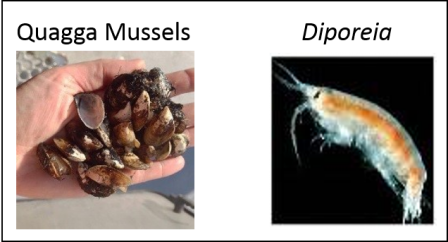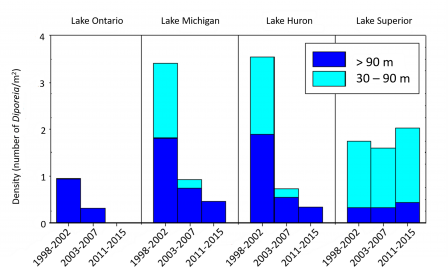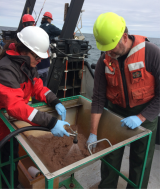Great Lakes Benthos Monitoring
On this page:
- What are benthos?
- Why does GLNPO monitor benthos?
- How does GLNPO sample and analyze benthos?
- What are the resulting data trends?
What are Benthos?
 (L-R) Dead and living quagga mussels; Diporeia
(L-R) Dead and living quagga mussels; Diporeia
NOTE: NOT TO SCALE
Benthic macroinvertebrates, or benthos, are small aquatic animals (including worms, crustaceans, bivalves, and aquatic larval stages of insects) that live on the bottom of the lake.
Types of benthos collected in the Great Lakees include:
- Crustaceans (amphipods such as Diporeia and isopods)
- Worms and leeches
- Insect larvae (mayflies and midges)
- Clams and mussels
- Snails
Why does GLNPO monitor benthos?
Benthos are an important part of the lower food web, serving as a food source for prey fish. Many benthic species are sensitive to the effects of chemical pollution and can serve as indicators of aquatic environmental health, too.
How does GLNPO sample and analyze benthos?
A PONAR grab sampler consists of two opposing semi-circular jaws held open by a trigger mechanism. The PONAR is lowered through the water column to the lake bottom, when contact with the bottom releases the trigger and snaps the jaws shut. Sediment and any resident benthic organisms from the lake bottom get trapped in the PONAR and are brought back to the ship.
After washing the finer sediment out of the samples, scientists pick the organisms out of the mud. In the laboratory, the benthic organisms are identified and counted using a microscope and then weighed. The resulting estimates of density![]() densityThe amount of mass per unit volume. and biomass
densityThe amount of mass per unit volume. and biomass![]() biomassThe amount of living matter in a given area or volume. are used to track changes in benthic populations from year to year.
biomassThe amount of living matter in a given area or volume. are used to track changes in benthic populations from year to year.
What are the resulting data trends?
 Since 1998, there has been a decline in Diporeia at both deep and shallow sites in Lake Ontario, and populations have not been found in the lake since 2010. There has been a decline in Diporeia populations at both deep and shallow sites in Lakes Michigan and Huron since 1998. In Lake Superior, the Diporeia populations have remained fairly constant since 1998.Populations of the benthic amphipod Diporeia, which serve as a rich food source to many important fishes in the Great Lakes, are declining.
Since 1998, there has been a decline in Diporeia at both deep and shallow sites in Lake Ontario, and populations have not been found in the lake since 2010. There has been a decline in Diporeia populations at both deep and shallow sites in Lakes Michigan and Huron since 1998. In Lake Superior, the Diporeia populations have remained fairly constant since 1998.Populations of the benthic amphipod Diporeia, which serve as a rich food source to many important fishes in the Great Lakes, are declining.
Invasive zebra and quagga mussels populations are increasing in the Great Lakes, having an extreme effect on both the water quality and lake bottom composition.
- The mussels feed on algae and filter the water, making the water clearer.
- The increased visibility allows more light to reach deeper waters, which enables aquatic plants to grow in deeper areas of the lakes.
- These water quality changes have been associated with changes in the food web and the loss of food sources for the Great Lakes fishery.
- The mussels also colonize the lake bottoms, taking away habitat from some benthic organisms, while providing habitat for others.


